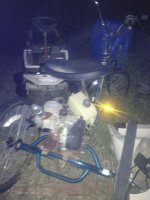Thank you for the tip!
Excellent information, good to know! So basically as long as I pre-lube everything, I should be OK starting the bike and leaving it on for a short period of time, even if oil does not flow or lacking oil pressure.
I had a look and changing the oil pump seems to be do-able for me but will take me some time, and I suppose the oil pump won't be cheap either.
I'll try blowing compressed air from the head then. I've got no ideas how the oil channels run on the engine, but blowing it back will send it to the filter I assume?
There's a ball bearing on the cams at end with the gears, and basically nothing at all (from what I can tell) on the other end. Just the cam on the surface of the head, with a layer of oil between. Is that what a plain bearing is? I'm unsure on translating some technical terms between Swedish and English.
To be honest, I do not know what a machine shop would be called in Swedish, nor where to find one

But what can be done to recover my parts? I can't see how any bearing can be fitted on the cam as one of the lobes are in the way.

 But what can be done to recover my parts? I can't see how any bearing can be fitted on the cam as one of the lobes are in the way.
But what can be done to recover my parts? I can't see how any bearing can be fitted on the cam as one of the lobes are in the way.


